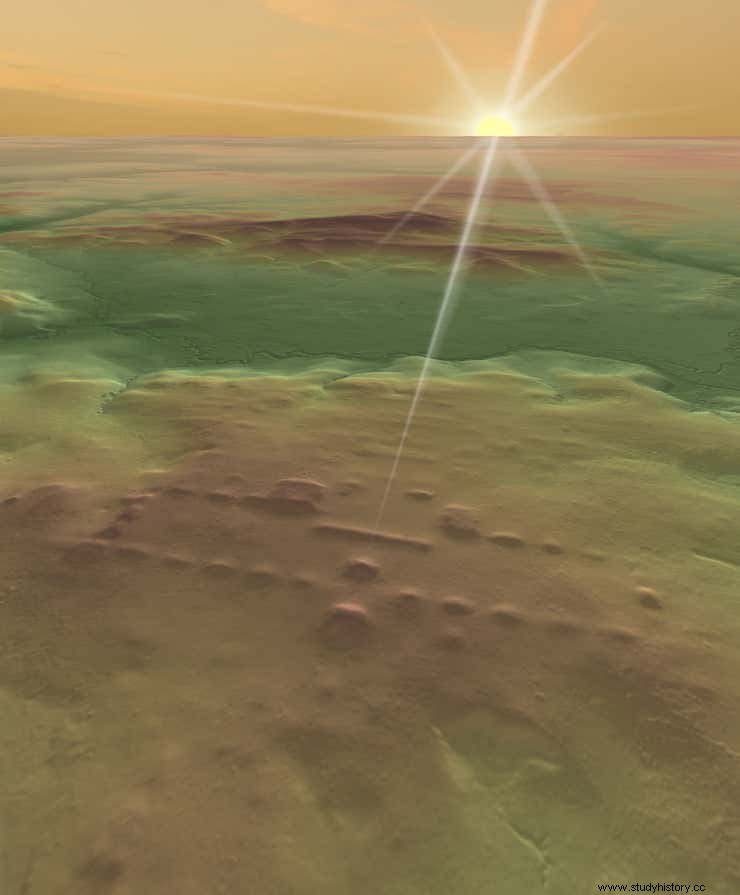This is a new harvest of the most auspicious for the archaeologists of Mesoamerica:no less than 478 new ceremonial sites have been detected thanks to LiDAR technology in the state of Tabasco, in southern Mexico. Their standardized blueprints indicate that this type of architecture was formalized earlier than researchers thought.

A LiDAR image of the Aguada Fénix site, discovered a little over a year ago in the state of Tabasco, Mexico. It was following this find that the excavations were continued by the same team in the region.
478 new Mesoamerican sites over more than 30,000 square meters, that's enough to keep archaeologists busy for several decades. This discovery, notable for its magnitude, was made in the Mexican state of Tabasco, in the southwest of the Yucatan Peninsula, using LiDAR (Light Detection and Ranging) aerial scanning technology. ). According to the researchers behind the find, which is the subject of an October 25, 2021 article in the journal Nature Human Behavior , they would be ceremonial complexes combining Mayan sites and older Olmec sites. All would have been active between 1,400 BC. J.C. and the year 1.000 of our era.
Invisible gigantism
With LiDAR, archaeologists can get accurate measurements of ground elevation change, even through dense tree cover, thanks to lasers that penetrate the ground and then bounce off a detector. In this way, valuable 3D maps can be developed that shed new light on entire territories, sometimes amply explored in the past. It is an understatement to say that LiDAR has upset the study of the Mayan world in recent years - among other things - by revealing countless totally unknown sites.

An illustration of the sun rising in line with the Mesoamerican site of Buenavista, recently identified using LiDAR. Credits:Takeshi Inomata
Once again, without this technology, the structures of the 478 new sites would probably never have appeared to archaeologists:low and very large, they are almost invisible to the naked eye, even from the sky. The team of scientists, led by University of Arizona Maya civilization specialist Takeshi Inomata, did not conduct their research in this area by chance. A little over a year ago, she detected the oldest and largest Mayan structure ever found there. Aguada Fénix, of its name, had proved to be the pre-Hispanic vestige of all records, with its 1400 meters long, 400 meters wide and its fifteen meters height, from which nine large causeways would radiate. In addition, 21 other sites, more minor, had been identified around the same time. What suggest to researchers that their excavations deserved to be deepened.
Because archaeological LiDAR surveys are expensive, Takeshi Inomata and his colleagues relied on public LiDAR data collected over 84,500 square kilometers by the Mexican government. Ordinarily, such topographic information is not used for archaeology, as its resolution is too low. But the researchers decided to exploit them effectively by comparing them with higher resolution maps and with in situ tracking. , walk. They themselves were surprised at the large number of new structures that revealed themselves to them.
Proof of a direct link between Olmecs and Mayas?
All the sites feature rectangular or square elements, which archaeologists believe could indicate that they were inspired by the famous Olmec site of San Lorenzo, whose rectangular central space was probably used as a public square. San Lorenzo is generally considered the first "city" of Mesoamerica, if not the oldest urban center of the entire American continent.
Even today, there remains a disagreement on the nature of the link between the Olmecs and the Maya:were the former the direct ancestors of the latter or should they rather be considered as a simple sister civilization? If the discovery of these many sites does not yet allow to decide, it suggests, according to archaeologists, that there existed between Olmecs and Mayas a shared culture. Specifically, it suggests that San Lorenzo may have inspired late Maya sites, including Aguada Fénix, says Takeshi Inomata. "People thought that San Lorenzo was really unique, and that it didn't have much to do with what came later" , explained the archaeologist to the site Artnet News .
An analysis that does not share the American Ann Cyphers, of the Institute of Anthropological Research of the National Autonomous University of Mexico (Unam), reference for the Olmec society:"From an architectural point of view, the two sites of Aguada Fénix and San Lorenzo looks very distinct to me , she said a year ago to Sciences et Avenir , when the discovery of the monumental site was announced. Currently, Aguada Fénix seems to me to have more affinity with sites in the Maya Lowlands or central Chiapas, rather than with the Olmec San Lorenzo."
Number 20 and the Mayan calendar
For Takeshi Inomata, the discovery of these sites would also push back the origin of the base 20 Mesoamerican calendar system several hundred years earlier. And for good reason:the structures also appear in groups of 20, a number which forms the basis of the written calendar of the Maya. Some architecture also appears to have been built to align with the sunrise on certain days, or with nearby mountains, perhaps suggesting symbolic significance. "This discovery forces us in any case to rethink what is happening during this period" , concludes Inomata.

A LiDAR image of the San Lorenzo (left) and Aguada Fénix (right) sites show similarities, with a long rectangular platform and 20 rim platforms. Credits:Franandez-Diaz/Inomata
Originating around 2,600 BC, the Maya civilization is known to have flourished in Central America for almost 3,000 years, reaching its peak between 250 and 900 AD. The Olmecs occupied the territory earlier, from around 2,500 to 400 BC.
